112 Sixty Five w/PI tube: Distorted preamp + buzzy chassis!?
Hello All! Thanks for all the help I've had so far on this great forum. This has been a great resource for my amp for the last decade!
My friend recently got a 112 65 with the PI tube for cheap, but it was distorting badly at low volumes (sounded ugly, maybe crossover distortion). I replaced the tubes, same story. While in there, I noticed that the electrolytic caps were all old, except for one which was way out of spec. I replaced all the electrolytics, and the distortion improved dramatically.
But the amp is still crunchier than what I'd expect. I have a 112 65 model without the PI tube, and I'd expect these two amps to sound pretty similar, since their preamp circuits are identical. But my friend's amp seems to break up more easily, and also has a lower output volume at the same settings. I ordered replacement LM307Hs, and I'm going to try to replace those in case one got fried from the bad caps I replaced.
Any other thoughts on why this amp would be so crunchy? It sounds like it's in the preamp, because it increases when I turn up the channel volume, but the master volume seems to provide clean gain.
There's one other thing I noticed while working on this amp. When it's powered on (with standby on and with it off) the chassis buzzes. Not the speaker, but the chassis. It kind of sounds like it's coming from the output driver board. In addition, when I grab the power switch on the front when it's on, it vibrates a little. This seems really bad! I'm gonna hold off on working on this until I get some input, because it seems kind of dangerous! I've been really safe working on these amps, discharging all the caps, checking them, one hand deep in my pocket whenever there's power, but I'm too young to die!
Thanks in advance for the help!
Member for
11 years 7 monthsMember for
11 years 7 monthsThank you for the suggestions
Thank you for the suggestions!
I checked my friend's amp through my amp's speaker and speaker cable, which are known good. Same issue.
Have new tubes and double checked the bias, both good.
Checked for voltages, they all look good.
I didn't swap in new LM307s from my amp, but I did swap in new ones that I got from ebay. The distortion issue remains, though I know that the new ones from ebay might be bad so I'll try swapping out the ones from my amp in the next couple weeks.
As far as the buzz and vibration, I think it's just a noisy transformer. I localized the sound and vibration to the smallest of the three transformers, a transformer that my amp doesn't have (I guess they're only in the PI 112 65s). It's the 3 Henry transformer that runs to point G on the schematic and then to the (screen grid of the?) power tubes. I'm not super worried about it knowing that it's transformer hum, I was just worried that the chassis was live and I was going to get shocked. Seeing that all the voltages test fine makes me pretty confident that's not the case!
Any suggestions on what else to check to try to fix this distortion issue? I'm uploading a sound sample so you can hear what I'm talking about. The audio is a little low quality, but you can hear the amp breaking up when I play more than a couple notes at once. I was playing a strat with the amp on normal settings: Channel volume 6, EQ all at 5, Reverb and Trem controls all at 0, master volume at 2.5.
Member for
11 years 7 monthsHV Power Supply
I suggest that the Hi Voltage power supply be thoroughly checked out. The 3H inductor (choke in the old days) is there for suppression of AC ripple on the HV voltages for the 12AX7. If it is buzzing, that is a sign that it is seeing far more AC ripple than the designers expected. It would be good to check to if one of the diodes in the Half Wave Voltage Doubler circuit (D9-D10) has shorted. Also, if the 3H inductor buzz became evident after the Cap replacement you mentioned, go back and double check the work for reversed polarity cap and stray solder blobs. -mgriffin
Member for
11 years 7 monthsI'll check those diodes next
I'll check those diodes next time I'm inside the amp! I don't remember if the buzz was there before I replaced the caps - it may have been. I definitely put the caps in the correct polarity (triple checked) and I'm pretty sure there's no stray solder blobs (I checked for continuity at each end of each cap, and they're all connected to the right places).
One solder pad did come off the PCB when I was replacing the caps, but I connected that cap lead really well to the trace. Is there anything else you think I should do to make this as clean a fix as possible?
Member for
11 years 7 monthsI know there was some
I know there was some variation as to where on the Volume dial the earlier 12AX7 PI tube Sixty-Fives started to breakup. Best I recall the first one I had years ago was clean until about 8. I've since played some that broke at 5 or 6. So your amp might be behaving normally.
That said...how loud can you crank the Volume with the Master at 10 before breakup? Any difference in behavior on Hi vs Lo power setting? Taking the Master Volume control out of the equation may (or may not) reveal a problem.
That little 3 Henry transformer is the choke, part of the DC power supply noise filter for the output tube grids. Works with the the 2 x 20uF filter caps to filter out noise. It went away with the 12AX7 tube PI. I think there is a way to jumper around it, would be interesting to see if the vibration and distortion then disappear. Hopefully someone here has done that and can advise.
Member for
11 years 7 monthsThanks for the reply! I
Thanks for the reply! I think you're right and the amp may be behaving normally! I was expecting it to sound very close to my 112 65 (without PI tube) at the same settings, but it makes sense that they'd be different. I usually set my amp with a channel volume of 5 or 6, and then a master volume of 1.5. For this amp, it sounds like I may need to do the opposite to get a clean tone - master volume at 5 or 6, with the channel volume down to 3 or so.
I will mess around with the channel volume while the master is at 10 next time I'm at my friend's house. I remember the same thing happening in the Hi and Lo power settings, but I'll double check that too.
Member for
11 years 7 monthsScope pics and next steps?
Hello all! I'm back to working on this amp again.
Biggest problem right now is the distortion. It is present at low levels, and does not sound nice. I borrowed a scope and took some readings. I'll attach them in following posts. All readings were taken with the knobs at the settings shown in the image in this post (ignore the scope image in this post - I don't know how to remove it):
1kHz tone sent to reverb/tremolo channel
Channel volume: 2
Treble: 5
Mid: 5
Bass: 4
Reverb: 0
Trem Speed: 0
Trem Intensity: 0
Master Vol: 3
All test points from the power supply tested good.
It seems like the distortion is coming from the preamp section - do you all agree? The signal tone has that chunk cut out of it at the end of the preamp, while the power amp seems to give clean gain to that signal.
I tried replacing the first op amp in the reverb/trem circuit (IC3) - same signal. I still need to test those two diodes on the rectifier board (D9 & D10) mgriffin - can I do that while their in circuit or do I need to remove them?
And the buzzy 3H transformer doesn't seem too bad now that I know it might just be transformer buzz. Will try tightening the mounting bolts and see if that helps. Unless it's related to distortion issue? Hopefully checking those diodes will solve that.
Thank you all for your help!
Edit: I'm attaching the schematic for reference
Member for
11 years 7 monthsMember for
11 years 7 monthsMember for
11 years 7 monthsMember for
11 years 7 monthsMember for
11 years 7 monthsMore mesaurements needed
Hi there,
your measurements are a good start. Off the top of my head I think you may have an issue in the low voltage power supply - one of the rails. If you inject signal from your generator into point D and tell us what you get from the speaker output, that should tell you something useful. Also is the issue the same if you inject signal into channel 1 instead of 2?
Good test points when using the scope are: Right at input (you have this), after tone stack (wiper of treble control) and point D.
Cheers,
Lars Verholt
Member for
11 years 7 monthsBad + rail!
Hi Lars and all,
Your intuition seems very right! Just measured the preamp rails.Negative rail seems good (-15.96V at the - end of C32), but the positive rail is only +7.3V at the + end of C31!
The voltages coming into the preamp board from the rectifier seem fine (+46.4V at point A, -46.8V at point B). Any idea what could be causing the bad + rail? Maybe D5 or D6? I replaced C31 and C32 when I did the recent recap job. Checked the caps for correct capacitance before installing them, and checked for continuity and correct placement after installing. But the trace at the - end of C31 lifted a bit when installing. I made sure I had a good connection though, and there is still continuity with R45, ground and... intermittent continuity with D5 and D6. I'm going to check the solder joints under those diodes and touch them up if needed.
Any other ideas of components/connections to check?
Thank you so much!
Member for
11 years 7 monthsD5 is suspect
Hello again,
I'd say D5 is certainly suspect. In theory you could also have a short downstream or your 620 ohm resistor has stretched a lot. If D5 is so bad that it breaks down at 7.3V instead of 16V it should be easy to measure with your ohmmeter which would put out roughly the 9V battery voltage as a test. Testing for a short downstream is a little trickier, you basically have to lift the terminals of the resistor and D5 then tie them together and measure what you get.
It wouldn't be the first time a Zener blew in these amps. If you find D5 is faulty, I would replace them both and go up one size in wattage (to 2 watts).
Cheers,
Lars Verholt
Member for
11 years 7 monthsWill check D5 right now
Great! I am inside the amp right now and will check D5.
Can you describe to me in detail how to check that diode? Sorry, I've never really tested diodes before. Should I set my DMM to resistance, and see what it reads across the terminals of the diode? And should I remove the diode from the circuit completely in order to do this?
Thanks!
Jacob
Member for
11 years 7 monthsBad D5 and D6
I just pulled both D5 and D6 and measured them with my multimeter on resistance.
D5 read 11.66kOhm with the COM connection of my DMM on the cathode, and 97kOhm with COM to anode. So it seems like it had shorted.
And D6 read 24.5MOhm with Com at the cathode, and an open circuit with COM at the anode. So it seems like it was an open diode.
Am I reading that right? Either way, I'll replace them both with 2W 16V zeners and see if that fixes the amp!
Also, check out the attached image of the circuit board under D5. Looks like it blew!
Thanks again for all your help
Member for
11 years 7 monthsMember for
11 years 7 monthsMember for
11 years 7 monthsMember for
11 years 7 monthsYeah! Vetco in the Seattle
Yeah! Vetco in the Seattle area. Great little shop, my cousin used to work there. I've been spoiled, when I lived in LA I was pretty close to All Electronics, an amazing store.
Vetco's closed for memorial day, so I'll pop in there on Tuesday and drop the new diodes in. I'll let you know how the amp looks after!
Thanks again for all your help y'all, my friend has a recording session booked next week and it'd be sweet to get her amp back to her in working order for it.
Member for
11 years 7 monthsIt just works!
Hello Lars and all!
The amp works! Replaced those two diodes last night and it sounds beautiful. Here's a picture with it on top of my 112 65. My friend's amp (on top, the one I just fixed) has an Altec 417B speaker in it - nice and heavy! Sounds warm and sparkly.
Thank you so much to everyone for all the help! I learned a lot, and I'm proud to have been able to help out a friend!

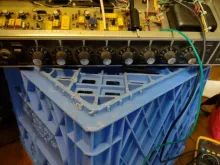
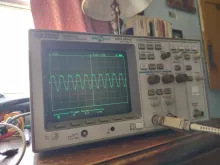
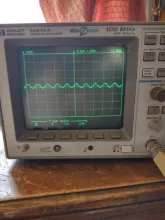
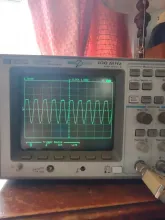

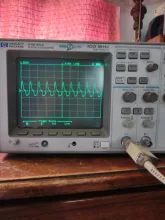
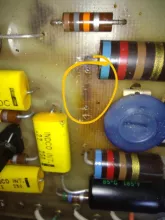
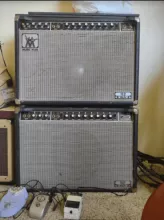
Hmmm...
Hmmm...
As far as volume and distortion issues:
Have you checked the volume output/tone clarity through a known good speaker?
Have you tried a known good speaker cable (they do go bad)?
Have you installed known good tubes?
Checked the bias?
Checked for correct voltages?
Swapped in known good LM307s (from your amp)?
Regarding the buzz and vibration:
If you are getting a buzz (mechanical) vs a hum (electrical), you may have a loose component in the chassis. Check that everything that should be bolted/screwed down tight to the chassis is so, especially the transformers. Check the bolts holding the sides of the transformers together too. If you can localize where the buzz is coming from, apply pressure (using a wooden or plastic probe) in the area to see if you can make the sound change. You might get lucky and find a bad solder joint, lifted board trace, or busted component.
It is possible you have loose laminations in your power transformer, which would explain both the sound and the vibration. Here is a video showing how to diagnose and repair. I would try that before purchasing and replacing transformers.
https://www.youtube.com/watch?v=dtOwewfqucI&feature=youtu.be
Good luck and let us know what you find.